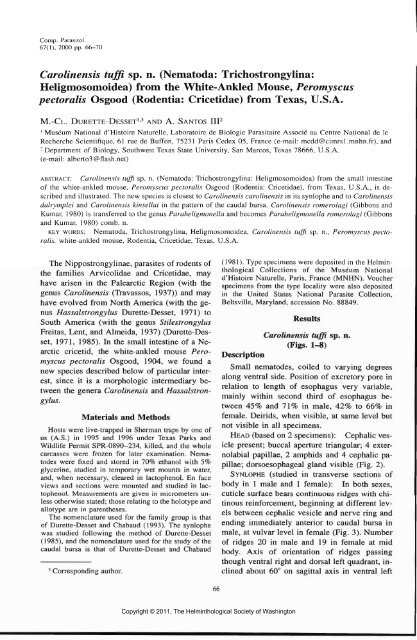Comparative Parasitology 67(1) 2000 - Peru State College
Comparative Parasitology 67(1) 2000 - Peru State College
Comparative Parasitology 67(1) 2000 - Peru State College
Create successful ePaper yourself
Turn your PDF publications into a flip-book with our unique Google optimized e-Paper software.
Comp. Parasitol.<br />
<strong>67</strong>(1), <strong>2000</strong> pp. 66-70<br />
Carolinensis tuffi sp. n. (Nematoda: Trichostrongylina:<br />
Heligmosomoidea) from the White-Ankled Mouse, Peromyscus<br />
pectoralis Osgood (Rodentia: Cricetidae) from Texas, U.S.A.<br />
M.-CL. DURETTE-DESSET1'3 AND A. SANTOS III2<br />
1 Museum National d'Histoire Naturelle, Laboratoire de Biologic Parasitaire Associe au Centre National de le<br />
Recherche Scientifique, 61 rue de Buffon, 75231 Paris Cedex 05, France (e-mail: mcdd@cimrsl.mnhn.fr), and<br />
2 Department of Biology, Southwest Texas <strong>State</strong> University, San Marcos, Texas 78666, U.S.A.<br />
(e-mail: alberto3@flash.net)<br />
ABSTRACT: Carolinensis tuffi sp. n. (Nematoda: Trichostrongylina: Heligmosomoidea) from the small intestine<br />
of the white-ankled mouse, Peromyscus pectoralis Osgood (Rodentia: Cricetidae), from Texas, U.S.A., is described<br />
and illustrated. The new species is closest to Carolinensis carolinensis in its synlophe and to Carolinensis<br />
dalrymplei and Carolinensis kinsellai in the pattern of the caudal bursa. Carolinensis romerolagi (Gibbons and<br />
Kumar, 1980) is transferred to the genus Paraheligmonella and becomes Paraheligmonella romerolagi (Gibbons<br />
and Kumar, 1980) comb. n.<br />
KEY WORDS: Nematoda, Trichostrongylina, Heligmosomoidea, Carolinensis tuffi sp. n., Peromyscus pectoralis,<br />
white-ankled mouse, Rodentia, Cricetidae, Texas, U.S.A.<br />
The Nippostrongylinae, parasites of rodents of<br />
the families Arvicolidae and Cricetidae, may<br />
have arisen in the Palearctic Region (with the<br />
genus Carolinensis (Travassos, 1937)) and may<br />
have evolved from North America (with the genus<br />
Hassalstrongylus Durette-Desset, 1971) to<br />
South America (with the genus Stilestrongylus<br />
Freitas, Lent, and Almeida, 1937) (Durette-Desset,<br />
1971, 1985). In the small intestine of a Nearctic<br />
cricetid, the white-ankled mouse Peromyscus<br />
pectoralis Osgood, 1904, we found a<br />
new species described below of particular interest,<br />
since it is a morphologic intermediary between<br />
the genera Carolinensis and Hassalstrongylus.<br />
Materials and Methods<br />
Hosts were live-trapped in Sherman traps by one of<br />
us (A.S.) in 1995 and 1996 under Texas Parks and<br />
Wildlife Permit SPR-0890-234, killed, and the whole<br />
carcasses were frozen for later examination. Nematodes<br />
were fixed and stored in 70% ethanol with 5%<br />
glycerine, studied in temporary wet mounts in water,<br />
and, when necessary, cleared in lactophenol. En face<br />
views and sections were mounted and studied in lactophenol.<br />
Measurements are given in micrometers unless<br />
otherwise stated; those relating to the holotype and<br />
allotype are in parentheses.<br />
The nomenclature used for the family group is that<br />
of Durette-Desset and Chabaud (1993). The synlophe<br />
was studied following the method of Durette-Desset<br />
(1985), and the nomenclature used for the study of the<br />
caudal bursa is that of Durette-Desset and Chabaud<br />
3 Corresponding author.<br />
(1981). Type specimens were deposited in the Helminthological<br />
Collections of the Museum National<br />
d'Histoire Naturelle, Paris, France (MNHN). Voucher<br />
specimens from the type locality were also deposited<br />
in the United <strong>State</strong>s National Parasite Collection,<br />
Beltsville, Maryland, accession No. 88849.<br />
Results<br />
Carolinensis tuffi sp. n.<br />
(Figs. 1-8)<br />
Description<br />
Copyright © 2011, The Helminthological Society of Washington<br />
66<br />
Small nematodes, coiled to varying degrees<br />
along ventral side. Position of excretory pore in<br />
relation to length of esophagus very variable,<br />
mainly within second third of esophagus between<br />
45% and 71% in male, 42% to 66% in<br />
female. Deirids, when visible, at same level but<br />
not visible in all specimens.<br />
HEAD (based on 2 specimens): Cephalic vesicle<br />
present; buccal aperture triangular; 4 externolabial<br />
papillae, 2 amphids and 4 cephalic papillae;<br />
dorsoesophageal gland visible (Fig. 2).<br />
SYNLOPHE (studied in transverse sections of<br />
body in 1 male and 1 female): In both sexes,<br />
cuticle surface bears continuous ridges with chitinous<br />
reinforcement, beginning at different levels<br />
between cephalic vesicle and nerve ring and<br />
ending immediately anterior to caudal bursa in<br />
male, at vulvar level in female (Fig. 3). Number<br />
of ridges 20 in male and 19 in female at mid<br />
body. Axis of orientation of ridges passing<br />
though ventral right and dorsal left quadrant, inclined<br />
about 60° on sagittal axis in ventral left
















